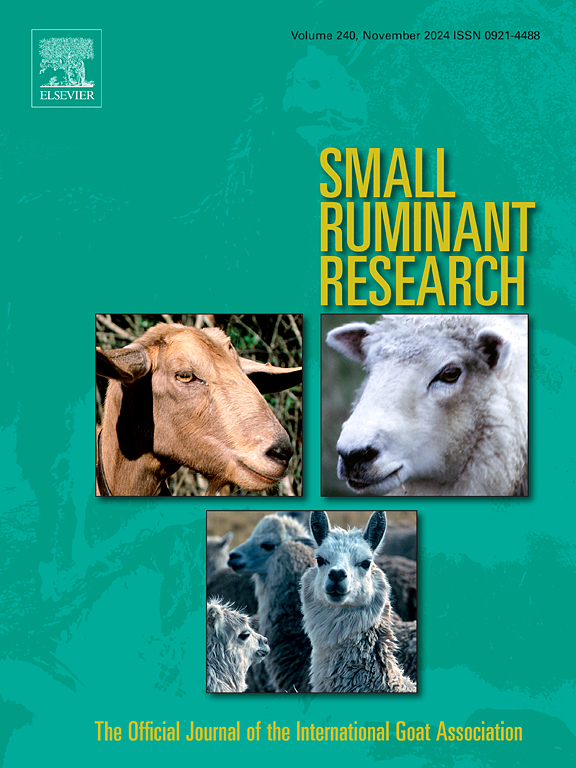气体疗法改善srlv感染奶山羊的慢性骨关节炎和生产力
IF 1.6
3区 农林科学
Q2 AGRICULTURE, DAIRY & ANIMAL SCIENCE
引用次数: 0
摘要
小反刍动物慢病毒(SRLV)是危害动物健康和生产的慢性进行性疾病。本研究旨在评价臭氧治疗对SRLV自然感染奶山羊不同临床、生产和超声指标的影响。共有42只成年Saanen山羊患有慢性关节炎和体重减轻的症状,经SRLV分子和/或血清阳性证实。将动物分为三个实验组:氧/臭氧组(n = 14);Goxygen (n = 14);和Gcontrol (n = 14)。臭氧治疗剂量为0.05 mg/kg。每月,在90天内,所有山羊进行临床检查,腕关节超声和生产指数采集。生产指标(体况评分[BCS]和体重)和临床指标(临床关节指数、生物特征指数和腕体积)均有治疗效果。与对照组相比,氧合组的BCS更高,氧合组得分与其他组相当(2.7 ± 0.4 ≠2.5 ± 0.3 = 2.6 ± 0.4 BCS)。与对照组相比,go氧/臭氧组和go氧组的体重更大(62.0 ± 9.9 = 61.2 ± 11.3 ≠57.2 ± 9.5 Kg)。在临床评估,Goxygen和Goxygen /臭氧获得较低的腕关节指数相比Gcontrol(8.2 ±1.0 = 8.2 ±1.3 ≠ 8.7±1.0 厘米)。在关节超声数据方面,与对照组相比,氧/臭氧和氧气指标较低。关节囊软骨下空间的距离(8.7 ±3.4 = 8.6 ±3.2 ≠ 11.0±4.3 毫米)、区域(153.7 ±68.1 = 156.2 ±69.4 ≠ 239.0±89.3 数目和周长(81.6 ±15.7 = 81.1 ±16.4 ≠ 101.7±15.9 毫米)腕损伤的突出显示。同样,在关节囊到软骨下间隙的距离、腕病变的面积和周长等超声参数上,也发现了治疗与时间之间的相互作用。综上所述,在目前条件下,两种气体疗法都可以安全地用于自然感染SRLV的奶山羊的关节临床症状和产奶率,表现为慢性关节炎和体重下降。本文章由计算机程序翻译,如有差异,请以英文原文为准。
Gas therapies improve chronic osteoarthritis and productivity in SRLV-infected dairy goats
Small ruminant lentiviruses (SRLV) are chronic and progressive diseases that compromise animal health and production. This study aimed to evaluate the ozone therapy on different clinical, production and ultrasound indices in dairy goats naturally infected by SRLV. A total of 42 adult Saanen goats with chronic signs of arthritis and weight loss were used after molecular and/or seropositivity to SRLV confirmation. Animals were allocated into three experimental groups: Goxygen/ozone (n = 14); Goxygen (n = 14); and Gcontrol (n = 14). A therapeutic ozone dose of 0.05 mg/kg was adopted. Monthly, throughout 90 days, all goats underwent a clinical examination, carpal ultrasound and production index collection. There was a treatment effect for production (Body Condition Score [BCS] and body weight) and clinical (clinical articular index, biometric indices and carpal volumes) indices. Goxygen/ozone showed a greater BCS when compared to Gcontrol, and Goxygen had a score equal to other groups (2.7 ± 0.4 ≠ 2.5 ± 0.3 = 2.6 ± 0.4 BCS). Goxygen/ozone and Goxygen had a greater body weight when compared to Gcontrol (62.0 ± 9.9 = 61.2 ± 11.3 ≠ 57.2 ± 9.5 Kg). In clinical evaluations, Goxygen and Goxygen/ozone obtained lower carpal joint indices when compared to Gcontrol (8.2 ± 1.0 = 8.2 ± 1.3 ≠ 8.7 ± 1.0 cm). Regarding joint ultrasound data, Goxygen/ozone and Goxygen had lower indices when compared to Gcontrol. The distance from the joint capsule to the subchondral space (8.7 ± 3.4 = 8.6 ± 3.2 ≠ 11.0 ± 4.3 mm), area (153.7 ± 68.1 = 156.2 ± 69.4 ≠ 239.0 ± 89.3 mm2) and perimeter (81.6 ± 15.7 = 81.1 ± 16.4 ≠ 101.7 ± 15.9 mm) of the carpal lesion are highlighted. Likewise, there was found interaction between treatment and time for ultrasound parameters of the distance from the joint capsule to the subchondral space, area and perimeter of the carpal lesion. In conclusion, both gas therapies, under the current conditions, can be safely used to improve joint clinical signs and production rates in dairy goats naturally infected by SRLV displaying chronic arthritis and weight loss.
求助全文
通过发布文献求助,成功后即可免费获取论文全文。
去求助
来源期刊

Small Ruminant Research
农林科学-奶制品与动物科学
CiteScore
3.10
自引率
11.10%
发文量
210
审稿时长
12.5 weeks
期刊介绍:
Small Ruminant Research publishes original, basic and applied research articles, technical notes, and review articles on research relating to goats, sheep, deer, the New World camelids llama, alpaca, vicuna and guanaco, and the Old World camels.
Topics covered include nutrition, physiology, anatomy, genetics, microbiology, ethology, product technology, socio-economics, management, sustainability and environment, veterinary medicine and husbandry engineering.
 求助内容:
求助内容: 应助结果提醒方式:
应助结果提醒方式:


